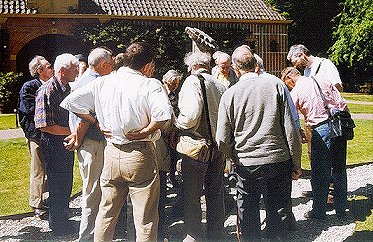
Multiple dials
Fraeylema Manor, Slochteren

The Dutch Sundial Society, on its 1999 summer field trip, made its first stop at Fraeylema Manor.
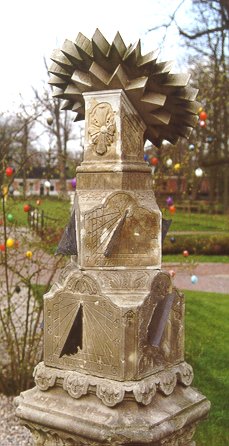 The multiple sundial here is similar to the one at Menkema Manor. The base carries two cubes, rotated 45°, with a vertical dial on each side. The whole looks somewhat more 'natural', though: no gilded angel's head, no gilded gnomons, and the sculpture is not painted white. On the other hand, it is capped by a sandwich of three multi-pointed stars.
The multiple sundial here is similar to the one at Menkema Manor. The base carries two cubes, rotated 45°, with a vertical dial on each side. The whole looks somewhat more 'natural', though: no gilded angel's head, no gilded gnomons, and the sculpture is not painted white. On the other hand, it is capped by a sandwich of three multi-pointed stars.
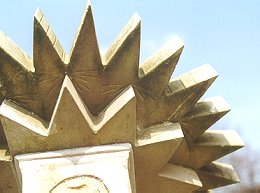 The large star has 24 points, eight of which carry the dial face of a small polar dial on both sides, as can be seen in the picture. In each case, the edge of the neighboring point serves as the pole-style of the dial.
The large star has 24 points, eight of which carry the dial face of a small polar dial on both sides, as can be seen in the picture. In each case, the edge of the neighboring point serves as the pole-style of the dial.
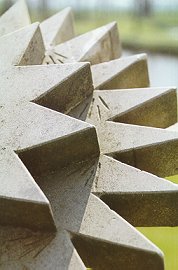 The two smaller stars each have 12 points. The edge of each serves as the pole style of a - very simple - equatorial dial. The 'dial faces' have hour lines, but apparently there was too little room for the hour numbers.
The two smaller stars each have 12 points. The edge of each serves as the pole style of a - very simple - equatorial dial. The 'dial faces' have hour lines, but apparently there was too little room for the hour numbers.
Hence, the three stars carry 40 sundials. Adding the 8 vertical dials on the base, this makes 48 dials altogether. A record high! The designer did not even need to include an equatorial dial on top of the upper star, as his colleague at Menkema Manor did.
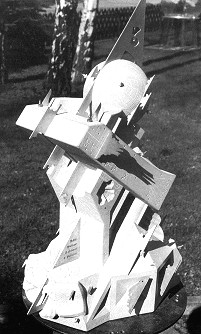 Forty-eight dials on one object presumably is a national record. Elsewhere, though, one may find much larger numbers. The object alongside is a replica of an 18th century specimen, which is in Wennigsen (near Hannover, Germany). It carries some 120 dials. The picture is from the book by Zenkert.
Forty-eight dials on one object presumably is a national record. Elsewhere, though, one may find much larger numbers. The object alongside is a replica of an 18th century specimen, which is in Wennigsen (near Hannover, Germany). It carries some 120 dials. The picture is from the book by Zenkert.
The multitude of dials on one structure certainly was not meant to be able to read the time comfortably from any angle. Rather, it was a masterpiece of the instrument maker, demonstrating his theoretical skills and craftsmanship. And for the nobleman it served as a showpiece of wealth and good taste to his guests...
The base is enclosed in four stone tiles, from which the combined correction for the time zone, equation of time and daylight saving time can be read. The gnomonists in the top picture just were discussing the ins and outs of this.
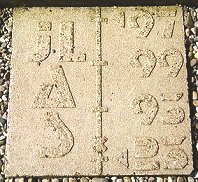 The tile at the left covers July to October. It lists the corrections for the first day of each month, in minutes. The cross on the line at the end of September denotes the end of daylight saving time. (Politics has played the designer a trick already: since 1996 the transition is made at the end of October.)
The tile at the left covers July to October. It lists the corrections for the first day of each month, in minutes. The cross on the line at the end of September denotes the end of daylight saving time. (Politics has played the designer a trick already: since 1996 the transition is made at the end of October.)
Take the top value, for example. The correction for Central European Time is about 33 minutes. On July 1 the sun is 4 min. slow. Together with the daylight saving time this adds up to 33 + 4 + 60 = 97 minutes, in accordance with the listing.
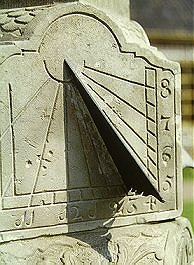 Unfortunately, the reading of the dial is not correct. The picture at the right was made on April 21. It shows the south-west dial on the upper cube. The other vertical dials that caught sunlight also gave readings between 12:00 and 12:05.
Unfortunately, the reading of the dial is not correct. The picture at the right was made on April 21. It shows the south-west dial on the upper cube. The other vertical dials that caught sunlight also gave readings between 12:00 and 12:05.The dial was made in 1735. It was located at Tilburg Manor, a couple of miles from here. That manor was pulled down in 1925, and the sundial ended up behind the chicken barn. After restoration, it was donated to Fraeylema Manor in 1986.
The Manor dates from the 16th century (the octagonal tower presumably is from that period) and saw many reconstructions through the ages. Its got its present look in the 19th century. From 1975 it is a museum, and also the wedding-room for Slochteren. The park has been laid out in the English style.

Location: 53.2° N, 6.8° E
Concise website on Fraeylema Manor (in Dutch)
Sundials at Menkema Manor
Sundial at Verhildersum Manor